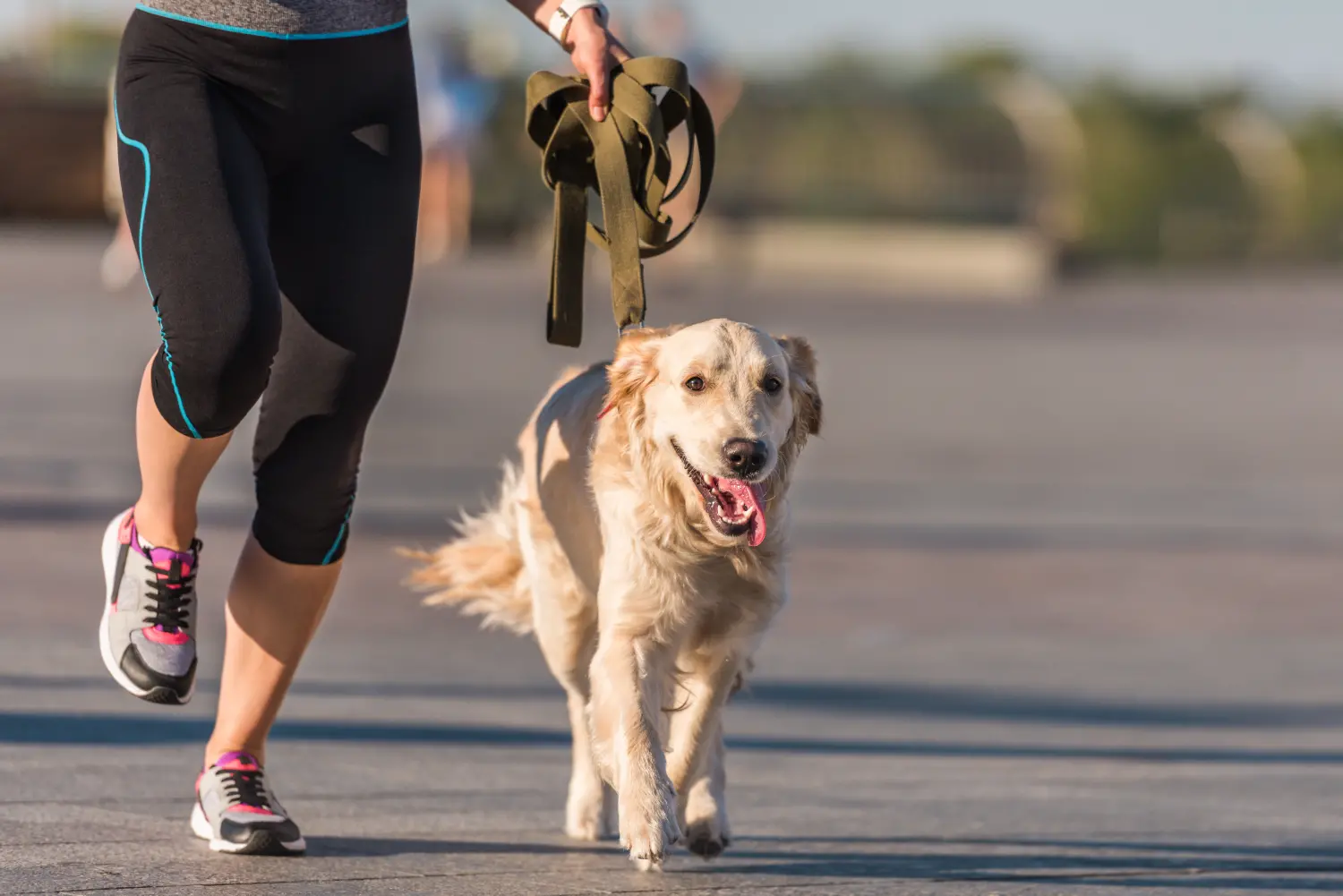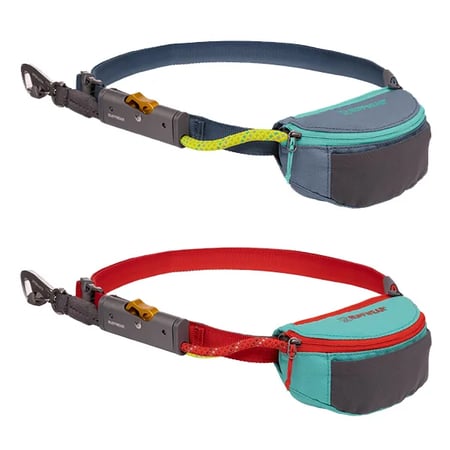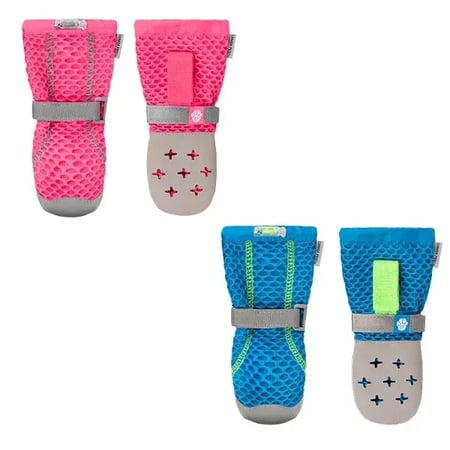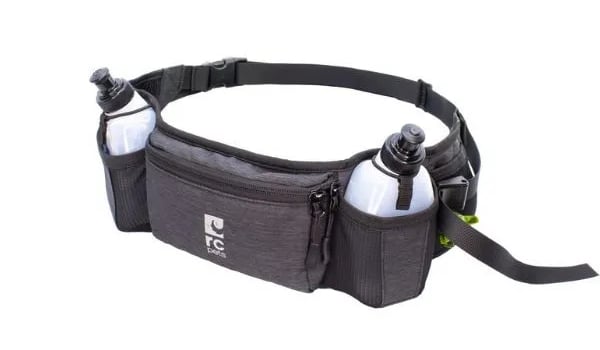
Are you looking for a high-intensity activity to do with your dog? Running with your dog might be the perfect way for both of you to exercise and help your pooch burn off some extra energy.
Are you ready to take your fitness routine to the next level while spending quality time with your furry friend? Running with your dog can be an exciting and rewarding experience for both you and your trusted best friend.
Not only does it provide an opportunity for exercise and bonding, but it also allows your canine companion to release their energy and fulfill their natural instincts.
You might be surprised to learn that training a dog to run with you isn’t that difficult with persistence, positive reinforcement, and the right gear.
In this article, we will explore running with dogs. Jogging with dog companions is a fun way to share your love of sport with your furry friends.
Whether you're a seasoned runner or just starting, this guide will provide you with valuable tips and insights on how to run with your dog effectively and safely - plus, we will cover the must-have dog running gear.
Get ready to hit the pavement together and embark on an exciting journey of fitness and adventure like never before by jogging with your dog!
Benefits of Running with Dogs
Yes, dogs make good running partners, but why bother training them to run with you when they can just run in the yard or at the park? Whether trail running with dogs or taking a simple jog, there are many benefits to learning how to teach a dog to run with you.
Running with dogs offers a multitude of emotional benefits that go beyond just physical exercise. Here are the top advantages of hitting the pavement with your four-legged companion:
-
- Strengthen Your Bond: Running together builds trust and deepens your connection with your dog.
- Stay Fit Together: Jogging helps maintain a healthy weight and boosts stamina for both of you.
- Boost Mental Stimulation: New sights, smells, and sounds keep your dog’s mind sharp and engaged.
- Improve Behaviour: Regular runs reduce boredom, anxiety, and destructive habits.
- Encourage Socialization: Runs expose your dog to new people, pets, and environments.
- Reduce Stress: Exercise releases feel-good hormones, helping you both relax and unwind.
- Stay Motivated: Your dog’s excitement can inspire you to stick to a routine.
- Make It Fun: Turn everyday runs into shared adventures through parks and trails.
How to Train Your Dog to Run With You
Whether you are trail running with dogs, jogging with dogs, or you want to go running casually, running with your dog is a remarkable adventure and easy to learn. Let’s examine how to teach a dog to run with you.
Training a dog to run with you can be a rewarding and enjoyable experience for both you and your furry companion. The best dogs to go running with are always your closest sidekicks.
Here are seven steps to help you get started:
1. Build up Fitness Gradually
If your dog is more of a couch potato than a star athlete, then you'll need to take it slow to prevent your dog from overexerting themselves. Dogs tend to prioritize fun over safety, so it's up to you to set achievable but realistic goals for both of you.
To get started, ensure your dog is in good health with a trip to the vet. An assessment of their mobility, weight, and muscle mass can help you decide how slowly your dog will adapt to a running routine.
When training a dog to run with you, gradually build their endurance through regular walks and shorter runs. Start with short distances and a slower pace, then gradually increase both as your dog's fitness level improves.
Check out our dog exercise calculator to get an idea of how much activity your dog needs every day.
2. Train Basic Commands
Before running with your dog, make sure your furry friend has a solid foundation in basic commands such as "sit," "stay," and "come." These commands will help you maintain control and ensure a safe running experience.
Additional phrases like "stop", "look", or "go" can also be useful depending on your route and environment. If you are running in an urban environment where you may need to cross roads, interact with pedestrians, and mind traffic, then these skills are a great way to teach your dog safe running habits.
3. Introduce a Proper Leash and Equipment
The tools you use for walking your dog might not be the right choice for running with dogs. Safety needs to be a top concern, so a well-fitting dog harness or dog collar will provide better control and minimize strain on your dog's neck.
The leash you choose can also make a big difference in how comfortable and safe your dog is. Here are a few leash types that work well for running:
-
- 6ft Nylon Leash - This standard leash is lightweight and the perfect length for jogging and running.
- Bungee Leash - Absorb the shock of sudden stops, turns, or pulls with a bungee leash.
- Rope Leash - Rope is one of the toughest and most durable leash options for running with big dogs.
- Hands Free Leash - For optimal balance and comfort, try a hands free dog leash.
Beyond these basics, other accessories for running with dogs can include:
4. Practice Good Leash Manners
For the safety of both you and your dog, it's a smart idea to teach your dog good walking behaviours. Teaching your dog not to pull on leash and to follow your directions will help make running with your dog more comfortable and safer.
Practice leash walking in a controlled environment until your dog can walk with a loose leash. As your dog gets better on leash, you can move on to more distracting environments and kick your walks up to a faster pace.
5. Use Positive Reinforcement
Reward your dog with praise, treats, or playtime for good behaviour during training and runs. Reinforce the desired behaviour and create positive associations when focusing on how to train a dog to run with you.
Using positive reinforcement and rewarding good behaviour can help your dog build confidence on leash and bolster your bond.
6. Start with Short Runs
Start with shorter running sessions to familiarize your dog with the rhythm and pace of running. Take it slow when focusing on how to teach your dog to run with you. You can gradually increase the distance and speed as your dog becomes more comfortable.
If you plan to practice off-leash running, make sure you stick to trails and parks that allow for off-leash dogs. Check out Recall Training for Dogs for tips on teaching good off-leash behaviours.
7. Maintain a Consistent Routine
Consistency is key. Stick to a regular running schedule to establish a routine for your dog. Dogs thrive on consistency and repetition, so maintaining a consistent running schedule will help them adapt and enjoy the activity.
Remember, every dog is unique, and the training process may vary. Be patient, stay positive, and adapt your approach based on your dog's individual needs and abilities. Enjoy the adventure of running with your dog and celebrate the progress you make together.
Best Dog Breeds to Run With
The best dog to jog with depends on several factors, including the dog's size, breed, energy level, and overall health. While many dogs can make great jogging companions, some breeds are naturally more inclined to enjoy running with you.
You might think that the best running dog companion is a greyhound, but other breeds also make great choices. What dogs are good for running with?
-
- Labrador Retrievers
- German Shepherds
- Golden Retrievers
- Vizsla
- Weimaraner
- Australian Shepherd
- Border Collie
Some small dogs like running too! Terriers, like Cairn Terriers, are often the best small dogs for running.
Ultimately, the best dog to run with is your furry buddy, regardless of breed. As long as they are physically capable and you gear your runs to their limitations, then your dog will be a great running companion.
Check out our list of the 40 best dog breeds, including the best breeds for hiking and adventures.
Running With Two Dogs vs. One Dog
Your dog can be the perfect running mate, but what if you have more than one dog? To avoid one of your furry friends from feeling left out, you could take them one at a time, but what if you could run with both dogs?
As we covered earlier, training a dog to jog with you is not difficult with the right steps, and teaching two or more dogs can also be a breeze with the right tools and a little bit of training.
The first step is to pick out sturdy leashes. Sturdy 6ft leashes are ideal for giving your dogs enough room to run without running into you or each other. Now, if you are wondering how to run with your dog on a leash if there is more than one, don’t worry.
When jogging with two dogs, you’ll need a double leash coupler (also called a leash splitter) so you can keep the dogs attached to a single leash for easy control. Each leash should be long enough to give each dog their own space to run with you comfortably.
Shop our huge selection of dog leashes and collars in Canada, so you have the right gear at your disposal.
When running with more than one dog, begin with short, controlled runs to allow the dogs to adapt to running alongside each other. This will help them get accustomed to the routine and build their endurance gradually.
Increase the distance and intensity of the run as both dogs become more comfortable and confident. Always try to match each dog’s energy levels to keep pace.
Stop frequently for hydration breaks for you and your pooch. When you first start running with your dog, it’s going to take time and practice for you both to get into your groove, and this is even more true if you are running with more than one dog at a time.
Remember to consult with a veterinarian if you have any concerns about running with your dogs.
Best Gear When Training a Dog to Run with You
When it comes to running with your dog, having the right gear can make the experience more enjoyable and safer for both of you.
Here are some top gear recommendations available at Homesalive.ca:
Ruffwear Hitch Hiker Leash: Look, No Hands!

The Ruffwear Hitch Hiker Leash is a hands-free multipurpose leash system allowing you to run comfortably while securely attached to your dog. The leash serves as a hand-free or regular leash. You can even hitch to a tree if necessary.
The adjustable length of the leash is 12 feet. Dog running doesn't have to be complicated. With the Ruffwear Hitch Hiker Leash, your pup enjoys the freedom of movement, so you can both enjoy a run together.
Canada Pooch Hot Pavement Boots

Protect your dog's paws from hot pavement or rough terrains with the Canada Pooch Hot Pavement Boots. These boots provide traction and prevent burns or injuries so you and your furry friend can enjoy worry-free trail running with dogs.
RC Pets Horizon Hip Pack

The RC Pets Horizon Hip Pack is versatile and can be worn around your waist or across your body. It offers storage space for treats, waste bags, and personal items, making it convenient for your runs.
With two mesh pockets, you can hold up to 280 ML of water for you and your furry friend. The hip pack has a convenient quick-release so you can safely detach from your pup in the event of an emergency.
Running With Dogs Do's and Don'ts
Running with dogs might seem straightforward, but it's best to be prepared and teach your dog to run with you the right way. Here are a few simple dos and don'ts for running with dogs:
Do: Start Slow
Even high-energy breeds need to build up their stamina and learn how to run with you safely. Practice short and steady jogs and work your way up to faster speeds and longer runs. This will help you recognize your dog's limits.
Don't: Assume All Dogs Can and Should Run
Not every dog is suited for running. Plenty of playful and energetic breeds may not be suited to running long distances. Dogs with short legs, dogs with health issues, and many giant and heavy breeds may struggle to run and could even injure themselves trying.
Here are a few breeds that may not be suited for running or may not want to run with you:
-
- Pugs
- Bulldogs
- Mastiffs
- Basset Hounds
It's also not recommended to run with young puppies. While they are still growing, running can add additional stress to their hips and joints and could lead to injury.
Smaller dogs finish growing sooner, around 1 year, while bigger breeds will continue to grow past 18 months. Talk to your vet to find out when it's safe to start running with your pup.
Do: Set the Pace
You should be in control of your speed while running with dogs. If you let your dog guide your run, it will teach unwanted and unsafe behaviours. It's up to you to choose a pace that is neither too fast nor too slow.
Don't: Ignore the Signs
Your dog will show signs of tiring, overheating, and injury, so it's important that you keep an eye on your dog and watch for these signs. Some panting and drooling is normal, but your dog should show improvement when you take a break.
Be aware of your dog's speed, too. If he starts to slow down or lag behind, it's a good time to take a break and hydrate.
Do: Check the Weather
Running is a great exercise for both you and your dog, but extreme temperatures can make running unsafe. If you take your dog running when it's hot and humid, they can dehydrate quickly. It's best to run at cooler times of day, like morning and evening.
At the same time, cold temperatures can be hazardous too. Your dog can suffer from frostbite without proper protective gear, like dog boots and a dog coat. Also, running on ice can lead to slips and falls that can cause serious injury.
Don't: Forget to Hydrate
Proper hydration is important for both you and your dog. Make sure you bring plenty of water and take breaks to hydrate frequently. Proper hydration will help to keep your dog cool even on a warm day.
Frequently Asked Questions About Running with Dogs

Can You Go Running with Big Dogs?
Yes, many big dogs can go running with you, but they may not be well-suited for difficult terrain or long runs. Stick to casual runs close to home instead of marathons to avoid over-stressing their joints. Giant breeds and large stocky breeds may not have the stamina that more agile large breeds do.
Do Dogs Like Running?
Yes, many dogs enjoy running and find it to be a pleasurable activity. Running provides your furry friend with physical exercise, mental stimulation, and the opportunity to explore their surroundings. Dog running is a natural action. In fact, Canines are born athletes who enjoy burning pent-up energy in a good run beside their human companion.
What is the Best Dog Breed to Jog With?
Some breeds are better suited to running and other high-energy activities. Labs, Vizslas, and Border Collies are a few dog breeds that enjoy running and require it to stay healthy and prevent bored behaviours. But just because your dog is not the ideal running breed doesn't mean they can't run.
What are the Best Leashes for Running with Dogs?
When it comes to choosing the best leash for running with dogs, there are a few options that offer convenience, control, and safety. Hands free leashes are a popular choice, but do take some getting used to. Bungee leashes, rope leashes, and nylon leashes are all good choices, too.
Should I Use a Harness When Running with Dogs?
Harnesses are an excellent tool for not only keeping your dog safe and close on a run, but they are also safer for your dog's neck. Collars can cause damage to your dog's neck if they stop abruptly or lunge. Some harnesses can also act as a handle to assist your dog over rougher terrain.
How Far Can I Run with My Dog?
The distance you can run with your dog depends on various things, such as the dog's breed, age, health, fitness level and physical capabilities. Some dogs have greater endurance to cover long distances. High-energy dog breeds may be able to run five miles or more, while some breeds may be better suited to shorter runs.
How to Run With a Dog That Pulls?
Running with a dog that pulls on the leash can be challenging, but with some training and techniques, you can improve their behaviour and make the running experience more enjoyable. It's best to teach good loose leash walking skills before you start running. Check out How to Stop a Dog From Pulling on Leash for more tips.
.png?width=200&height=66&name=logo%20(1).png)






